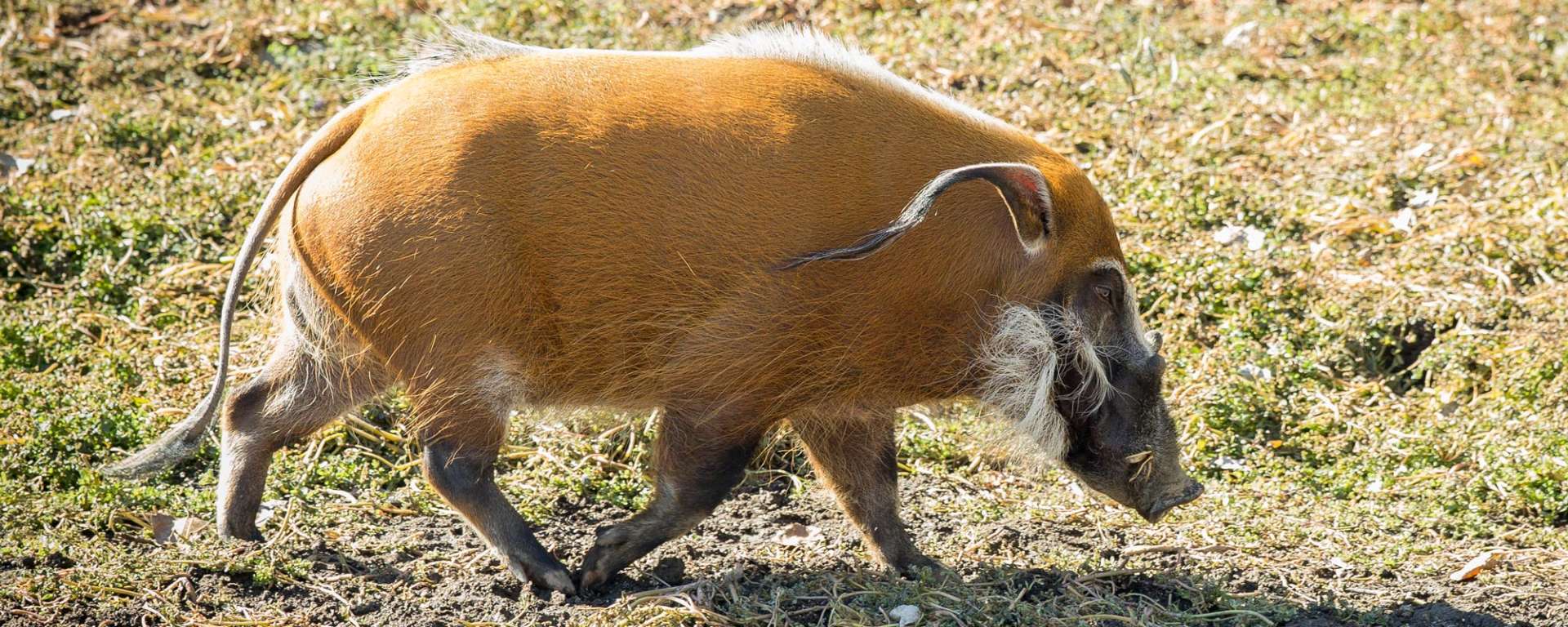Description
There is no mistaking this species as anything but a pig. Their name references their beautiful rust colored coat, but there is more than red in these hogs. The red river hog face presents dichromatic markings of black and white, though black covers most of it. They maintain a thin dorsal mane of white fur and long black tassels of hair that hang from their leaf shaped ears. Though you will notice a size difference between male and females as in most mammals, the easiest way to distinguish the two is to spot the large ‘warts’ or ridges above the males eyes.
Classification
- Class
- Mammalia
- Order
- Cetartiodactyla
- Family
- Suidae
- Genus
- Potamochoerus
- Species
- P. porous
- Conservation Status
- Least Concern
Key Facts
- Height
- 1.8-2.6 ft (~55-80 cm)
- Weight
- 99-264 lb (~45-120 kg)
The IUCN Red List describes Potamochoerus porcus as a species of Least Concern. Major threats come from human influences in over-hunting or persecution as agricultural pests.
Social Life
Red river hogs have been known to be either solitary or social animals. When social, they form groups, called sounders, which will vary from a typical 3-6 individual congregation to large aggregations of up 100. Despite their group size, this species is primarily active in the evening, spending their days in burrows surrounded by thick forest greenery. When threatened by predators these hogs may respond by either playing dead if they are too young to fight or run, running away if they can, or standing their ground in displays of considerable courage.
Habitat and Range
Typically found throughout the rainforests or gallery forests of West and Central Africa, red river hogs rarely stray far from the comfort of thick vegetation. They are, however, highly adaptable omnivores and have been spotted in a variety of other habitats on occasion.
Diet
The ideal generalists, red river hogs are best classified as opportunistic omnivores. The range of their gastronomic variety may include roots, fruits, seeds, water plants, nuts, fungi, insects, eggs, reptiles, carrion, small mammals, and domestic animals.
Lifespan
Life expectancy in captive and wild red river hogs seems similar in range, from roughly 15-20 years.
Predators
Main predators include leopards, lions, hyenas, and pythons.
Reproduction
Sexual maturity: Male: 2-3 years, Female: 1-2 years
Mating Season: September to April
Birth Season: November to February (Wet season)
Gestation: 3.5-4 months
No. of Young: 3-4
- Information
-
Description
There is no mistaking this species as anything but a pig. Their name references their beautiful rust colored coat, but there is more than red in these hogs. The red river hog face presents dichromatic markings of black and white, though black covers most of it. They maintain a thin dorsal mane of white fur and long black tassels of hair that hang from their leaf shaped ears. Though you will notice a size difference between male and females as in most mammals, the easiest way to distinguish the two is to spot the large ‘warts’ or ridges above the males eyes.
Classification
- Class
- Mammalia
- Order
- Cetartiodactyla
- Family
- Suidae
- Genus
- Potamochoerus
- Species
- P. porous
- Conservation Status
- Least Concern
Key Facts
- Height
- 1.8-2.6 ft (~55-80 cm)
- Weight
- 99-264 lb (~45-120 kg)
- Conservation
The IUCN Red List describes Potamochoerus porcus as a species of Least Concern. Major threats come from human influences in over-hunting or persecution as agricultural pests.
- Lifestyle
Social Life
Red river hogs have been known to be either solitary or social animals. When social, they form groups, called sounders, which will vary from a typical 3-6 individual congregation to large aggregations of up 100. Despite their group size, this species is primarily active in the evening, spending their days in burrows surrounded by thick forest greenery. When threatened by predators these hogs may respond by either playing dead if they are too young to fight or run, running away if they can, or standing their ground in displays of considerable courage.Habitat and Range
Typically found throughout the rainforests or gallery forests of West and Central Africa, red river hogs rarely stray far from the comfort of thick vegetation. They are, however, highly adaptable omnivores and have been spotted in a variety of other habitats on occasion.Diet
The ideal generalists, red river hogs are best classified as opportunistic omnivores. The range of their gastronomic variety may include roots, fruits, seeds, water plants, nuts, fungi, insects, eggs, reptiles, carrion, small mammals, and domestic animals.Lifespan
Life expectancy in captive and wild red river hogs seems similar in range, from roughly 15-20 years.Predators
Main predators include leopards, lions, hyenas, and pythons.Reproduction
Sexual maturity: Male: 2-3 years, Female: 1-2 years
Mating Season: September to April
Birth Season: November to February (Wet season)
Gestation: 3.5-4 months
No. of Young: 3-4

